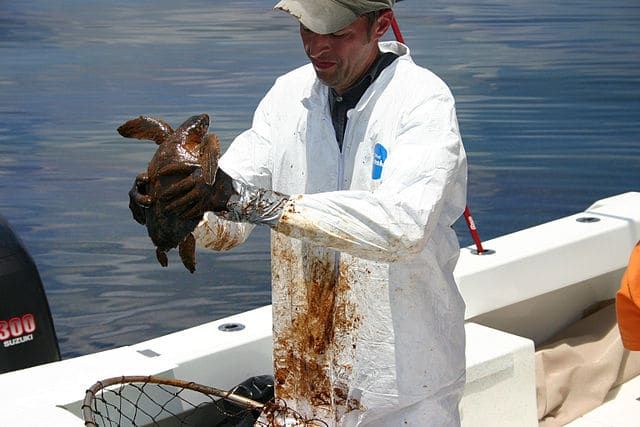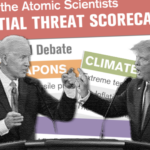Environmental disaster, revisited
By Dan Drollette Jr | September 25, 2014

“As the public becomes more concerned with the fundamental threat to human existence posed by the continuing degradation of the environment that sustains us, it will follow that judges, reading the same newspapers and magazines, will also begin to want to do something about the problem. Judicial sympathy will go a long way…”
The words sound like they could have come from a news analysis ripped from today’s headlines about disputed compensation for victims of the 2010 Gulf oil spill—a dispute in which US District Judge Carl Barbier decided that oil giant BP cannot recoup what it contends were earlier overpayments to affected businesses.
But this commentary was actually published more than 40 years ago in the pages of the Bulletin of the Atomic Scientists. Written by Northwestern University law professor Anthony A. D’Amato, it subsequently went on to become reprinted as part of a handbook on environmental law.
In that 1970 Bulletin article, “Environmental Degradation and Legal Action,” D’Amato wrote that short and costly environmental trials tend to favor defendants—such as BP—due to their vast legal resources: “An expensive trial usually redounds to the benefit of the utility (or other defendant). It has great resources to conduct legal battles, whereas plaintiffs typically are loath to contribute much to a public-interest lawsuit that will benefit the non-contributors as much as it will help themselves.”
But, he noted, long trials tend to favor the plaintiffs, as the publicity takes a huge toll on things such as BP’s public image. And companies, like people, like to go where they are welcome—and the oil company is not popular in the Gulf right now.
These comments certainly ring true for BP, slapped a few weeks ago with a fine that may reach $18 billion for its negligence leading up to the Deepwater Horizon blowout that killed 11 workers and caused millions of barrels of oil to spew into the Gulf of Mexico. In the case, Judge Barbier concluded that BP was reckless, and, in his 153-page judgment, he apportioned 67 percent of the blame for the disaster to the UK-based multinational.
It seems that clear-cut environmental disasters such as oil spills generally tend to provoke a strong reaction from the judiciary and the public. Tar-like material from a spill sweeping up onto the beaches and coating wildlife is graphic, highly visible evidence that almost anyone can immediately comprehend. Even the most unlikely citizens get aroused and ready to turn to the courts after confronting it, and D’Amato noted “the demonstrations and activism of the previously staid Santa Barbara citizens after the [1969] oil spills.”
Bulletin coverage of the environment—like media coverage in general—seems to have increased when there was a big environmental event in the news such as the Santa Barbara oil spill, the first Earth Day, or Saddam Hussein’s setting Kuwait’s oil fields on fire and dumping oil into the Persian Gulf as acts of retribution. As much as anything else, these spectacular occasions serve as reminders of the big picture: What humans do affects the planet, in a big way.
In an October 1970 Bulletin article, “Science and the Quality of our Environment,” W.T. Pecora, then-director of the US Geological Survey, wrote that humankind should be thought of as a geological agent acting on the same scale as the shifting of tectonic plates or the eruption of volcanoes: “This inter-reaction of man with nature is without question a most important issue of future years. In a society that has reached maturity in the industrial sense, the issue of environmental alteration becomes more and more acute. It is within this framework that certain actions of 100 or 200 years ago are now considered sinful… A major pipeline traversing Alaska should not be constructed without added safeguards to protect the natural environment. Offshore drilling for petroleum should not be endorsed without the added cost of providing maximum safeguards against pollution. Cities and industries should not use the water available from natural resources without factoring in the cost of returning the water in a usable state… The science and technology which have made possible the great advance of mankind can surely pay attention to these matters and resolve them…
"We find ourselves in the midst of a conflict between the need to develop the Earth’s resources and the desire to preserve the Earth’s environment—both, presumably, for the salvation of mankind.”
This observation was echoed in a September 1990 Bulletin article, “Telling the Public About Risks,” by John Ahearne—then-executive director of Sigma Xi, the scientific research society. He wrote: “Many disputes are not about facts, scientific data, or clauses in the law, but about values. Disputes are often about whether a particular benefit is worth the cost, and to whom.”
Editor’s note: The full archive of Bulletin print issues—from 1945 to 1998 and complete with covers and other illustrations—is available here.
Together, we make the world safer.
The Bulletin elevates expert voices above the noise. But as an independent nonprofit organization, our operations depend on the support of readers like you. Help us continue to deliver quality journalism that holds leaders accountable. Your support of our work at any level is important. In return, we promise our coverage will be understandable, influential, vigilant, solution-oriented, and fair-minded. Together we can make a difference.
Topics: Analysis, Special Topics














